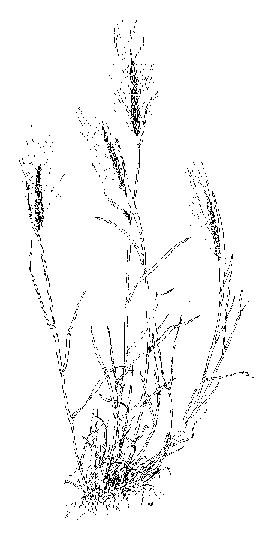| | Cultural control options | Control with glyphosate | In-crop control for oilseeds and pulses
Foxtail barley (wild barley, Hordeum jubatum) is a shallow-rooted, perennial bunchgrass common to non-cropland areas in Alberta. It has good tolerance to salinity and spring flooding, and it is capable of productive growth on all soil types. Figure 1 shows the adult plant.

Figure 1. Foxtail barley
Source: C. Frankton and G.A. Mulligan. 1987. Weeds of Canada. NC Press Limited and Agriculture Canada. Courtesy NC Press Limited
Foxtail barley becomes more of a concern whenever tillage intensity and frequency are reduced because few herbicide control options are available. The plant has a shallow, fibrous root system that makes it more susceptible to control by tillage than many other perennial weeds.
Foxtail barley seeds germinate at or near the soil surface in the cooler temperatures of fall or spring. Seed heads are easily carried by the wind, which enables them to spread quickly from field margins or within fields. Seed viability declines rapidly after three years.
Infestations can develop quickly where crop competition is poor due to soil salinity, drought, poor crop establishment or poor weed control practices. Fall-seeded cereals may allow foxtail barley levels to increase because the crop and weed develop during the same period with few herbicide control options.
Cultural Control Options
Tillage usually provides good control of foxtail barley. For zero tillage systems, a combination of herbicides and cultural practices is required for control. Research by Agriculture and Agri-Food Canada at Lethbridge has shown that the use of higher seeding rates and banding instead of broadcasting fertilizer can increase crop yields by giving crops a competitive advantage over foxtail barley.
Control with Glyphosate
Herbicides containing the active ingredient glyphosate applied at 0.5 litres/acre (formulations with 360 grams of active ingredient per litre) control spring and fall-germinating seedlings (less than 8 cm in height). This rate only suppresses mature plants. Control of mature plants requires glyphosate rates of 1 to 2 litres/acre. Late summer or fall applications encourage glyphosate movement into the root system. Control with glyphosate is improved by good growing conditions.
Pre-seeding or Summerfallow
A pre-seeding glyphosate application at 0.5 litres/acre controls young foxtail barley plants (less than 8 cm in height) and provides some suppression of mature plants, with 1 to 2 litres/acre controlling a range of foxtail barley plant sizes. The higher rate is needed to kill mature plants or plants that are stressed.
Post-harvest
Post-harvest glyphosate gives the best root-kill of established foxtail barley if soil moisture conditions allow the plants to remain actively growing. Optimum uptake and movement of glyphosate into foxtail barley roots occur at temperatures above 10°C.
In-crop Control for Oilseeds and Pulses
Research by Agriculture and Agri-Food Canada at Lethbridge has shown that several herbicides registered for grassy weed control in oilseed or pulse crops, while not registered for foxtail barley control, can provide control or suppression of foxtail barley seedlings (Table 1).
Assure gave the best results while Poast, Select, Fusion and Venture provided some suppression. Consult the Blue Book (Crop Protection, Agdex 606-1) for herbicide registration details.
Table 1. Foxtail barley control in flax a
| Herbicide b | Foxtail barley growth stage |
 | 3- to 4-leaf stage | 2- to 3-tiller stage |
 | %control | % yield increase | %control | % yield increase |
| Assure | 99 | 79 | 97 | 53 |
| Poast | 85 | 71 | 66 | 40 |
| Select | 74 | 56 | 57 | 33 |
| Fusion | 61 | 50 | 31 | 14 |
| Venture | 51 | 43 | 17 | 11 |
a. Agriculture and Agri-Food Canada, Lethbridge research data; average of three years (1995-97) for control data and two years (1996-97) for yield data; foxtail barley infestation levels averaged 163/m2.
b. Applied at the recommended rate for wild oat control and with the recommended rate of surfactant.
Summary
Foxtail barley is a tough-to-control perennial weed in zero tillage systems. Herbicides containing glyphosate can effectively control seedlings at relatively low rates with much higher rates required for control of mature plants. Cultural practices that encourage a competitive crop, such as high seeding rates and banding of nitrogen fertilizer, help to reduce yield losses and slow the spread of foxtail barley.
Prepared by:
Rob Dunn , Alberta Agriculture and Food and Dr. Bob Blackshaw, Agriculture and Agri-Food Canada.
Factsheets in the Direct Seeding Series are also available through Alberta Agriculture’s Internet site.
Source: Agdex 519-15. Revised October 2007. |
|